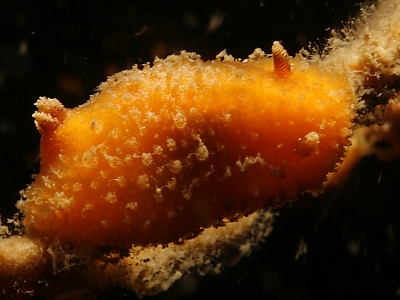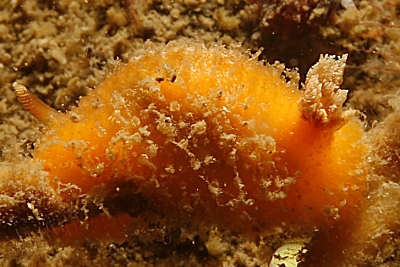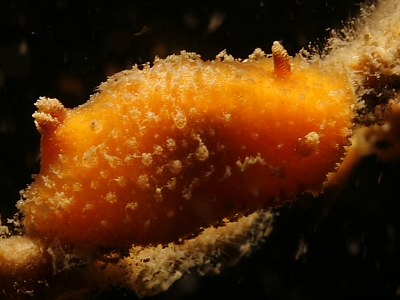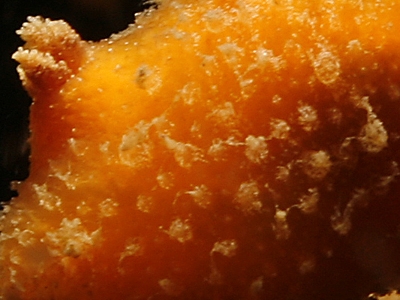

Thordisa azmanii
Cervera & Garcia-Gomez , 1989
Order: NUDIBRANCHIA
Suborder: DORIDINA
Superfamily: EUDORIDOIDEA
DISTRIBUTION
Atlantic coast of the Iberian Peninsula
PHOTO
Ria, Galicia, 25 meters, Spain, Atlantic Ocean, 27 October 2007, on sponge. Length: 20 mm. Photographer: Jacinto Pérez.
Like all species of Thordisa, the mantle is covered with retractile tapering papillae. The background colour is a dark orange brown and the papillae have scattered white patches. The lower half of the gills is a dark brownish colour while the upper half is whitish, and the rhinophores are similarly coloured.
This species has been recorded from northern Iberian Peninsula (from Asturias) by Ortea and Martinez (1990) under the name of T. diuda Marcus, 1955, which they considered a synonym of T. azmanii, but Chan and Gosliner (2006) consider the two species to be distinct.
It has similarities externally to T. filix, but that species is lighter in colour and has many more mantle papillae. Internally, the prostate of T. azmanii, which is arranged in a large spiral, is quite different from the cylindrical form of the prostate in the other species of the genus.
-
Chan, J.M. & Gosliner. T.M. 2007. Preliminary Phylogeny of Thordisa (Nudibranchia: Discodorididae) with Descriptions of Five New Species. The Veliger, 48(4): 284–308..
-
Cervera, J. & Garcia Gomez, J. 1989 A new species of the genus Thordisa. (Mollusca: Nudibranchia) from the southwestern Iberian Peninsula. The Veliger, 34(4): 382–386.
-
Cervera, J. L., Calado, G., Gavaia, C., Malaquias, M. A. E., Templado, J., Ballesteros, M., García-Gómez, J. C., and Megina, C. (2006) An annotated and updated checklist of the opisthobranchs (Mollusca: Gastropoda) from Spain and Portugal (including islands and archipelagos). Boletín Instituto Espanol de Oceanografía 20: 1-122.
-
Ortea, J. & Martínez, E. 1990. Captura en la Concha de Artedo de Thordisa diuda Marcus, 1955 (Nudibranchia: Doridacea), un nuevo molusco anfiatlántico. Boletín de Ciencias de la Naturaleza del Instituto de Estudios Asturianos, 40: 3-11.
-
Ortea, J. A. & Valdes, A. 1995. Una nueva especie de Thordisa Bergh, 1877 (Mollusca: Nudibranchia: Discodorididae) de las costas Angola. Avicennia, 3:35–41.
Rudman, W.B., 2008 (March 27) Thordisa azmanii Cervera & Garcia-Gomez , 1989. [In] Sea Slug Forum. Australian Museum, Sydney. Available from http://www.seaslugforum.net/find/thorazma
Related messages
Re: Thordisa filix? from northern Spain
March 27, 2008
From: Juan Lucas Cervera
Concerning message #21477:
Dear Bill,
I apologize my overlooking part of the distribution of Thordisa azmanii. Yes, this species has been also recorded from southern Portugal and from an area of southern Lisboa. Nevertheless, I think that the Galician animal is T. azmanii.
Concerning to the spiral-shaped prostate, this this is the main feature of T. filix (see Pruvot-Fol, 1951), not of T. azmanii nor T. diuda. I hope to have clarified this issue.
Best.
Lucas.
lucas.cervera@uca.es
Cervera, J.L., 2008 (Mar 27) Re: Thordisa filix? from northern Spain. [Message in] Sea Slug Forum. Australian Museum, Sydney. Available from http://www.seaslugforum.net/find/21478Dear Lucas,
Thanks for clarifying these points so quickly and sorry for misinterpreting your comments about the prostate. That T. filix has a spiral prostate makes much more sense.
Best wishes,
Bill Rudman
Re: Thordisa filix? from northern Spain
March 27, 2008
From: Juan Lucas Cervera
Concerning message #21053:
Dear Bill and Jacinto,
I think this species is not Thordisa filix (the westernmost record is from the Strait of Gibraltar) but T. azmanii Cervera & Garcia-Gomez , 1989. This last species has been recorded from northern Iberian Peninsula (from Asturias) by Ortea and Martinez (1990) under the name of T. diuda Marcus, 1955. However, in a recent paper Chan and Gosliner (2006) confirm that both species are different.
The angle of the light from the flash does not permit to appreciate the browish ground color of this species (much darker than T. filix). Moreover, the papillae have an opaque white pigmentation (not present in T. filix) and the number of papillae are lower than in T. filix.
Although it is difficult to see, I can appreciate that the upper regions of rhinophores and gills are also white (the lower region are dark brown).
Fron an internal point of view, T. filix has a prostate completely different from the remaining species of the genus, since is arranged as a very big spiral visible inmediately when you dissect this species.
-
Chan, J.M. & Gosliner. T.M. 2007. Preliminary Phylogeny of Thordisa (Nudibranchia: Discodorididae) with Descriptions of Five New Species. The Veliger, 48(4): 284–308..
-
Cervera, J. & Garcia Gomez, J. 1989 A new species of the genus Thordisa. (Mollusca: Nudibranchia) from the southwestern Iberian Peninsula. The Veliger, 34(4): 382–386.
-
Ortea, J. & Martínez, E. 1990. Captura en la Concha de Artedo de Thordisa diuda Marcus, 1955 (Nudibranchia: Doridacea), un nuevo molusco anfiatlántico. Boletín de Ciencias de la Naturaleza del Instituto de Estudios Asturianos, 40: 3-11.
-
Ortea, J. A. & Valdes, A. 1995. Una nueva especie de Thordisa Bergh, 1877 (Mollusca: Nudibranchia: Discodorididae) de las costas Angola. Avicennia, 3:35–41.
Best.
Lucas.
lucas.cervera@uca.es
Cervera, J.L., 2008 (Mar 27) Re: Thordisa filix? from northern Spain. [Message in] Sea Slug Forum. Australian Museum, Sydney. Available from http://www.seaslugforum.net/find/21477Thanks Lucas,
It's species like this that need a local expert to be sure. Concerning the distribution of T. filix, I used the Table III in your checklist (Cervera et al, 2006) and thought Galicia was one of the 'spots' for that species, but misread the spots. However on checking I see you list it as occurring on the Portugese coast which suggests it has an overlapping distribution with T. azmanii which seems confined to the Atlantic coast. I would be grateful if you could clarify that.
Also what is the animal that Ortea & Martínez (1990) identified as T. diuda? In your checklist you identify it with T. azmanii but from their illustration of its reproductive system, its prostate is not the spiral shape you say is characteristic of T. azmanii.
- Cervera, J. L., Calado, G., Gavaia, C., Malaquias, M. A. E., Templado, J., Ballesteros, M., García-Gómez, J. C., & Megina, C. (2006) An annotated and updated checklist of the opisthobranchs (Mollusca: Gastropoda) from Spain and Portugal (including islands and archipelagos). Boletín Instituto Espanol de Oceanografía 20: 1-122.
Best wishes,
Bill Rudman
Thordisa filix? from northern Spain
March 26, 2008
From: Jacinto Pérez


Note added 27 March 2008: This is Thordisa azmanii [see message #21477]
Hello Bill,
I found this nudibranch in Galicia (north of Spain), what is it?
Locality: Sea (Ria), 25 meters, Spain, Atlantic Ocean, 27 October 2007, on Sponge. Length: 20 mm.. Photographer: Jacinto Pérez.
Thanks,
Jacinto Pérez
buceo@hydronauta.com
Pérez, J., 2008 (Mar 26) Thordisa filix? from northern Spain. [Message in] Sea Slug Forum. Australian Museum, Sydney. Available from http://www.seaslugforum.net/find/21053
Dear Jacinto,
I am not an expert on nudirbanchs from your part of the world but I think this is Thordisa filix. It is normally thought of as Mediterranean but I see that Cervera et al (2006) record it from Galicia, on the Atlantic coast. Species of Thordisa have taepring retractile papillae over their mantle. Looking at your photos I am pretty sure the papillae are retracted. Then again I could be wrong, so let's wait for some words from local experts.
-
Cervera, J. L., Calado, G., Gavaia, C., Malaquias, M. A. E., Templado, J., Ballesteros, M., García-Gómez, J. C., and Megina, C. (2006) An annotated and updated checklist of the opisthobranchs (Mollusca: Gastropoda) from Spain and Portugal (including islands and archipelagos). Boletín Instituto Espanol de Oceanografía 20: 1-122.
Best wishes,
Bill Rudman
